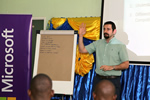
Microsoft has established a base at HIT through its Virtual Academy which is running a series of courses which began with the cloud-computing platform (Azure), to promote skills development and access to affordable technologies in local contextualized innovations.
 A team from the Microsoft Virtual Academy held a four-day seminar with students from the School of Information Science and Technology to introduce them to the new cloud-computing technology, Azure.
A team from the Microsoft Virtual Academy held a four-day seminar with students from the School of Information Science and Technology to introduce them to the new cloud-computing technology, Azure.
Students had the opportunity to familiarize with Azure; learning the different services that it offers. Students were also invited to explore Azure by observing how other students from across Africa are benefiting from the use of the new technology.
Microsoft AZURE is a cloud computing platform and infrastructure, created by Microsoft, for building, deploying and managing applications and services through a global network of Microsoft-managed data centres. It provides both Platform as a Service (Paas) and Infrastructure as a Service (Iaas) services and supports many different programming languages, tools and frameworks, including both Microsoft-specific and third-party software and systems. Azure was released on 1 February 2010.
Cloud computing is a computing term or metaphor that evolved late 2000, based on utility and consumption of computer resources. Cloud computing involves deploying groups of remote servers and software networks that allow centralized data storage and online access to computer services or resources. Clouds can be classified as public, private or hybrid
Students were given Azure one-month passwords, which will allow them access to this platform where they can use services to gain more knowledge on the platform.
Ryno Rijnsburger, a facilitator at the event, expressed gratitude to HIT for affording them the opportunity to introduce and interact with HIT students "This shows HIT’s commitment in terms of up-scaling and enhancing the academic experience of its students", he said.
Martin Mudhuva, a Part Four student from the Information Security and Assurance Department said he has learnt a lot from the seminar regarding cloud computing; a new technology that is evolving. "I really appreciate Microsoft’s effort in imparting this knowledge to us as students. I now have a clear overview and a good appreciation on cloud computing technology and their AZURE platforms.", he said.
Another student from the same department, Ripai Mangava said the seminar was a privilege as her class had just been learning about cloud computing and AZURE. " I had some concerns about security regarding cloud computing. Now I know that its secure and I am going to include this aspect of cloud computing in my Capstone Design project", she said.
The Microsoft Azure Platform provides an API built on REST, HTTP, and XML that allows a developer to interact with the services provided by Microsoft Azure.
 Microsoft also provides a client-side managed class library, which captures the functions of interacting with the services. It also integrates with Microsoft Visual Studio, Git and Eclipse.
Microsoft also provides a client-side managed class library, which captures the functions of interacting with the services. It also integrates with Microsoft Visual Studio, Git and Eclipse.
Cloud computing relies on sharing of resources to achieve coherence and economies of scale, similar to a utility (like the electricity grid) over a network. At the foundation of cloud computing is the broader concept of converged infrastructure and shared services.
The present availability of high-capacity networks, low-cost computers and storage devices as well as the widespread adoption of hardware virtualization, service-oriented architecture, and autonomic and utility computing have led to a growth in cloud computing. Companies can scale up as computing needs increase and then scale down again as demands decrease Cloud vendors are experiencing growth rates of 50% per annum.
The goal of cloud computing is to allow users to take benefit from all of these technologies, without the need for deep knowledge about or expertise with each one of them. The cloud aims to cut costs, and helps the users focus on their core business instead of being impeded by ICT obstacles.
The main enabling technology for cloud computing is virtualization. Virtualization software separates a physical computing device into one or more "virtual" devices, each of which can be easily used and managed to perform computing tasks. With operating system–level virtualization essentially creating a scalable system of multiple independent computing devices, idle computing resources can be allocated and used more efficiently. Virtualization provides the agility required to speed up ICT operations, and reduces cost by increasing infrastructure utilization. Autonomic computing automates the process through which the user can provision resources on-demand. By minimizing user involvement, automation speeds up the process, reduces labor costs and reduces the possibility of human errors.